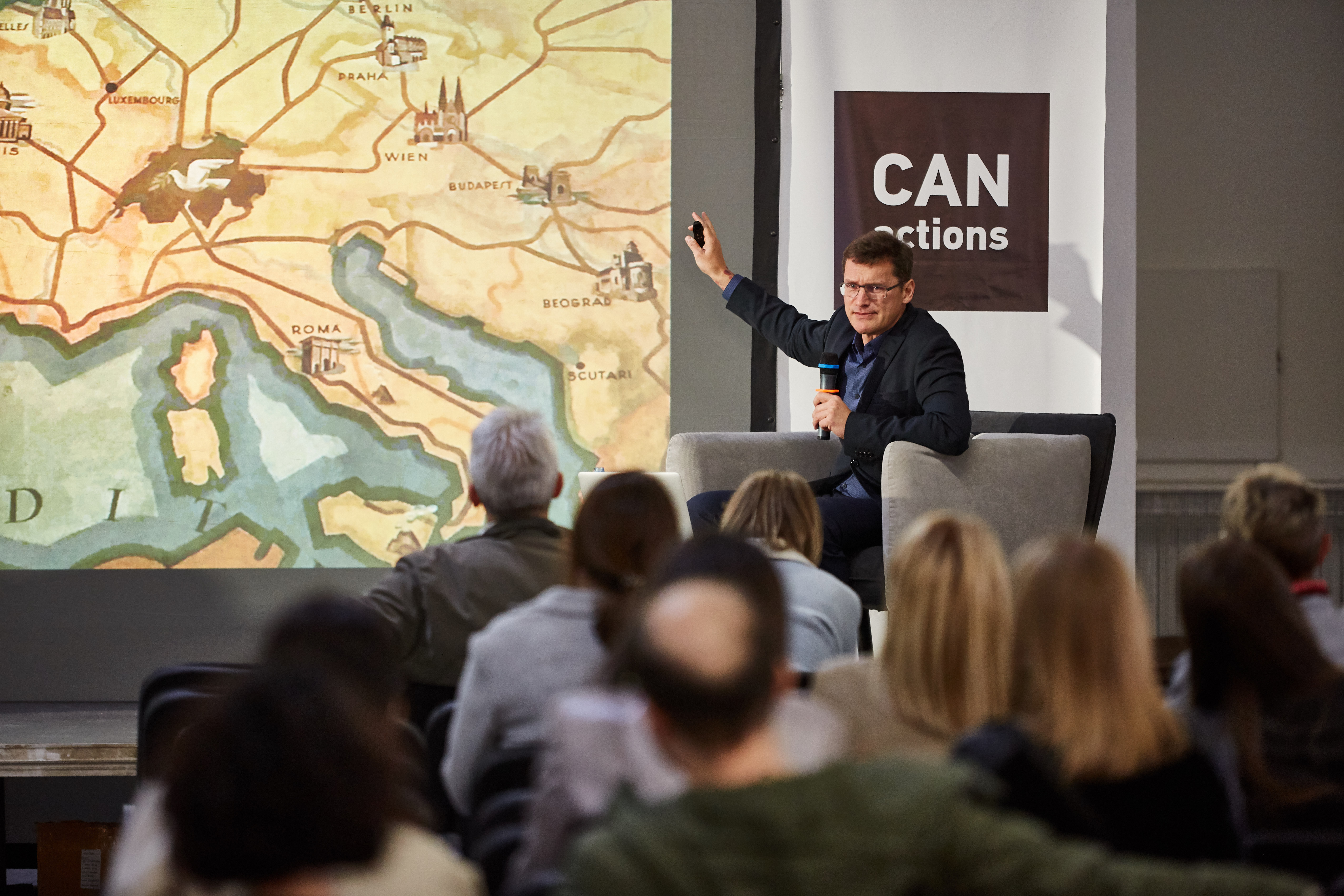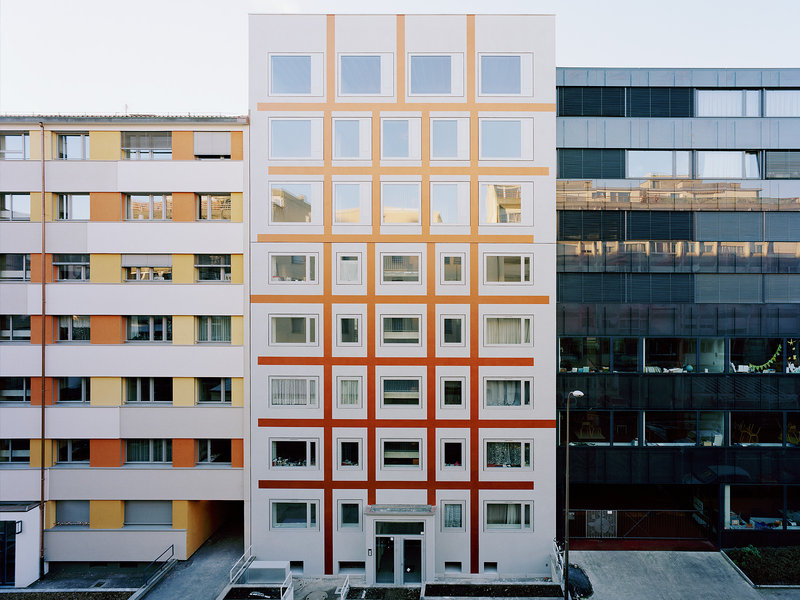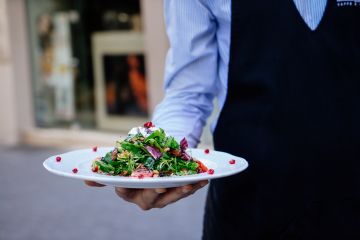The Schweizweit exhibition is essentially a topography of architectural work in Switzerland, which demonstrates the common features and differences of the problems, as well as formal strategies that are relevant today for Swiss architects.
About Multicultural Switzerland
Photo: Andreas Ruby giving a lecture in Kyiv
Switzerland is interesting and strange place. Do you know that it is 15 times smaller than Ukraine? However it has triple density: in Ukraine the estimated density is 71 people per square km, while in Switzerland the number is 206. It means that Switzerland has much denser urban environment. Moreover, if you consider that a third of the country is Alpine territory and can’t be built upon, it means that the surface of the land you can actually build on is even smaller.
Read: Paint It Black: Ukrainian Monocolor Art in Sergey Makhno Gallery
Ben Vautier, a local artist, was so inspired by Switzerland peculiarities that he named his exhibition “Switzerland doesn’t exist!” (“La Suisse n’existe pas!”). At the time the exhibition was opened, the Swiss population reacted with protest — they didn’t understand what he wanted to say. What he did want to say is, Switzerland doesn’t exist as one homogenous monolithic entity. It’s a place that is riddled with difference and has so many different cultures that the whole idea of the unity of a nation is very feeble. There are very few things in Switzerland that are the same for everybody — the train system, the postal system and the army. Almost everything else is locally different. Most importantly, there’s not one national language — but four. It is not so obvious for Swiss people to really identify with each other.
About Poet Max Frisch
Photo: Schweizweit exbition
Switzerland has also given a way for a poet Max Frisch, who has written an interesting book full of questionnaires dedicated to philosophical topics like love and Heimat — one of the most difficultly translated German words. It basically refers to a condition when “I feel at ease”. He invented a questionnaire of 26 questions, which are really difficult to answer, because the more you answer the more you rig yourself in contradictions. For instance if you meet a fellow citizen abroad, do you feel more homesick or less homesick?
About the Exhibition
Photo: S AM in Basel
When I started to work for S AM two years ago, I wanted to do something similar with the concept of Swiss architecture. I did two exhibitions – the one that is shown here in Kyiv and a smaller one, called “Imagine la Suisse” that was located outside the museum in a public space. The opening of the exhibition was actually held on sidewalk. That way people understood that museum is not only something inside of the building but inside of the city. It created a mapping of people’s ideas of what Switzerland looks like.
Read: Famous Ukrainian Art: Modern Artists
It was like foreplay for the Schweizweit exhibition. The purpose is to show that Swiss architecture has developed quite dramatically in the past few decades. In the 1990s it became world-famous for a certain kind of language — minimalism — architecture of a geometrical reduction and abstraction. For instance, the Museum of Art in Bregenz by architect Peter Zumthor or works by Peter Märkli, a famous architect in Switzerland. All of them have this language of dramatically-shaped, boxy buildings. For about twenty years the image of Swiss architecture was coded by this type of cliché. However, in the meantime it has changed a lot and it’s necessary to update the idea of the Swiss architecture. This is the purpose of the exhibition we brought to Kyiv.
About Modern Swiss Architecture
Photo: building designed by Peter Märkli
Today two younger generations of architects are practicing and when you see their works you realize there’s no longer one principle but an insane amount of different approaches on how to make architecture. It comes to the factors I’ve spoken about at the beginning – Switzerland has very little common points to identify as homogeneous nation. One could almost say that the most important denominator of Swiss architecture is its perpetual difference. The main thesis that this exhibition has produced is that absence of one general principle defines identity of Swiss architecture. You can even say it’s a negative identity — to define something best by what it is not. For me it’s an inspiring understanding of identity in our day and age. We see our contemporary political landscape antagonized, these are conflicts of identity. The very obvious one would be politicization of religions like Islam, Christianity and Judaism. All these conflicts can be upheld only as long as the identity of things in conflict remains homogenous.
Read: 3 Ukrainian Murals in Top of the World
But what happens if we acknowledge if our identity isn’t one but is more? There’s a famous saying by Arthur Rimbaud – “I is another”. He is actually grammatically incorrect and this type of understanding that identity is something plural, not single, is very important if we want to live in peace. That’s why I’m interested in the state of the Swiss architecture — it embodies this understanding of an identity that is in constant transformation.
I’ll give an example:
Photo: Raphaël Nussbaumer Architectes Sàrl in Geneva
The building you look at is actually not one but two. One was built in the 1960s and the other — 5 years ago. However, we don’t really see the boundary between them. The architect tried not to make an antagonistic relationship with the new and the old but a transitional gradation. The lower part of the building has been built in 1960s, while upper floors of the building are new — you can see that the orange grid is slightly displaced, and the windows are larger. This building also says: “I am not one, I am at least two — or I am one about to turn into something else”.
Many young Swiss architects that are very conscious in trying not to replace something existing but to transform and modulate it. If we apply this understanding to our own identity, many antagonisms would dissolve.
Conclusion 
Photo: Andreas Ruby in Kyiv
I believe that architecture is an expression of more fundamental conditions in which we live. The statement of this exhibition is to celebrate the idea of a diversity that is not exclusive but integrative. There is not ‘one’ Swiss architecture — it’s not an affirmation of formal eclecticism but an expression of hope for different kind of understanding of the relationship of nations. People consume architecture in their close context without noticing much what other people do in other cities or regions.
Read: The New Transforming Concert Hall in Odesa
This exhibition presented the entire architectural production of the country placed in one continuous space of perception. Many saw differences as a sign of hope and inspiration. So I encourage you, if the next time you wake up after a party, look in the mirror and aren’t sure of the person you see — don’t despair. Be hopeful!
Photos by Andrey Mikhaylov, S AM, bestarchitects.de, mimoa.eu. All images belong to their rightful authors.
Andreas Ruby about Philosophical Vision of Architecture
On April 19, Lavra Kyiv Municipal Gallery hosted a grand opening of the Schweizweit exhibition within CANactions International Architectural Festival. The exhibition was organized by S AM - Swiss Museum of Architecture and its director, Andreas Ruby, gave a lecture reflecting the peculiarities of the Swiss urban space.







